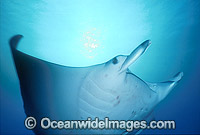
Manta ray Manta birostris (above).
Manta ray Manta birostris silhouetted
(below).
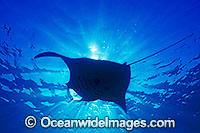 |
|
Rays are wondrous sea creatures. They
are the birds of the underwater world, often captivating
divers by their graceful movements and elegant manners.
They are found in all ocean from abyssal depths to shallow
reefs and estuaries even existing in some freshwater streams.
There are more than 500 different
kinds of rays known throughout the world, many with exquisite
markings and polka-dots, others with long whip-like tails.
They're generally flat bodied, having broad-winged pectoral
fins extending from the tail to the sides of the head. When
fully grown, rays can vary in disc width from just a few
centimetres to more than 6m and weigh a staggering 1360kg.
The manta ray is the largest ray and may exceed 9m in width,
although documented sightings are yet to be confirmed. Apart
from the mantas, which spend much of their time on or near
the surface feeding on plankton, most rays live close to
the sea floor where they feed largely on invertebrates and
occasionally small fish - but many will readily scavenge
for food.
All rays bear their young live, except
skates, which are oviparous (produce eggs that hatch outside
of the body).
Not all rays are flat, or disc shaped.
The shovelnose ray (guitarfish) and sawfish are rays that
have shark-like bodies with two large dorsal fins of almost
equal size. People often confuse these rays with sharks,
especially the harmless shovelnose which enjoys a diet of
sand-dwelling critters in shallow inshore waters.
Like sharks, rays have a skeleton
made of cartilage (not bone); they possess a battery of
finely tuned sensory systems for locating prey and their
skin is covered in small toothlike projections called denticles.
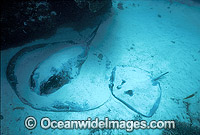 Blotched fantail stingray Teiniura meyeni
(right).
Blotched fantail stingray Teiniura meyeni
(right).
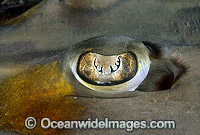 Detailed view of the eye of a shovelnose ray
(left). Detailed view of the eye of a shovelnose ray
(left).
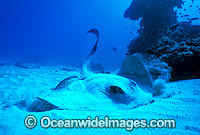 Blotched fantail stingray Teiniura meyeni (right). Blotched fantail stingray Teiniura meyeni (right).
|
|
Identifying the ray group is made easy
by the location of the gill openings, which are always on
the lower, light coloured surface. The mouth and nostrils
are usually located on the bottom of the head and the eyes
on top of the head. None of the rays attack people; they
all have a docile nature and prefer to flee threatening
situations. However, rays should be treated with the respect
they deserve as many, such as the electric ray, stingaree
and stingray, have very effective defence mechanisms.
The torpedo, coffin and numb ray are
all electric rays capable of transmitting powerful electric
charges. They have special organs situated behind the eyes
on either side of the head, which they use to stun fast
moving prey and for defence.
The stingaree and stingray bear one
or more venomous spines on the base of the tail, capable
of delivering an excruciatingly painful wound. These rays
often bury themselves into sedimentary bottoms when resting
and if accidentally trod on, will defend themselves by thrusting
the tail upwards and forward with remarkable speed to impale
the victim. When walking over sandy bottoms a simple shuffle
of the feet would prevent any injuries of this kind.
If left undisturbed, many of the large
rays will often allow divers to move in close. Some, such
as the mantas, will even show surprising curiosity towards
the diver, especially when they are being serviced at an
underwater fish cleaning station. This allows an excellent
opportunity to observe these leviathans closely and a chance
for spectacular photography.
The most famous rays in the world
known for interacting with divers are without a doubt the
southern stingrays (Dasyatis americana) of Grand Cayman
Island, situated off the British West Indies. These rays
show absolutely no fear of divers and snorkellers, who feed
them offerings of fishscraps at a place locals call Stingray
City. An experience with these rays is absolutely mind-boggling,
one far beyond imagining.
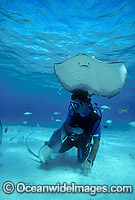
A scuba diver swims amongst Southern stinrays
(Dasyatis americana) at Stingray City, Grand
Cayman Island in the British West Indies (left).
An underwater photographer photographs obliging
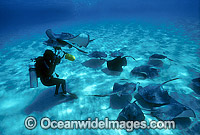 subjects
- the southern stingrays at Stingray City, Grand
Cayman Isand (right). |
|
Mantas of the Gulf of California are
also very popular. These animals seem to actually enjoy
physical contact with divers. The reason still remains a
mystery. Unfortunately the future of these mantas is threatened
by exploitation by local fishermen and their numbers are
sadly dwindling.
The skate is probably the most abundant
ray in the ocean but few kinds are seen by divers as the
majority live in the deeper waters on the continental slopes.
In Europe and other parts of the world, rays and skates
are fished commercially as important primary produce, with
catches being considerably large in some regions. While
world catches are small in comparison with the commercially
important bony fishes, controlled fishing measures are nevertheless
important if these target fisheries are to survive. Unlike
most of the bony fishes, rays generally grow slowly and
sexually mature late in life before producing relatively
few young.
Should the ray fauna be indiscriminately overfished and
mature adults depleted from marine habitats, the effects
could prove disastrous by causing severe upset within the
sea's eco-system.
We are fortunate in Australia to have
some of the richest ray fauna in the world, with 73% being
endemic to the region. However, like so many marine animals,
we really know very little about these fascinating sea creatures.
We can only take care of their environment as best we can
and stare in admiration as they glide through our lives.
Text: Meri & Gary Bell
Photography: Gary Bell
|

